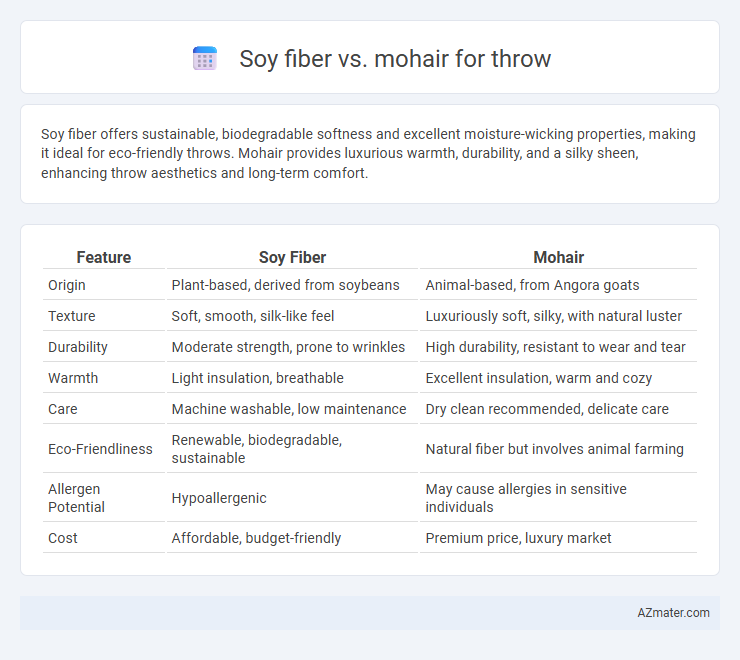Soy fiber offers sustainable, biodegradable softness and excellent moisture-wicking properties, making it ideal for eco-friendly throws. Mohair provides luxurious warmth, durability, and a silky sheen, enhancing throw aesthetics and long-term comfort.
Table of Comparison
| Feature | Soy Fiber | Mohair |
|---|---|---|
| Origin | Plant-based, derived from soybeans | Animal-based, from Angora goats |
| Texture | Soft, smooth, silk-like feel | Luxuriously soft, silky, with natural luster |
| Durability | Moderate strength, prone to wrinkles | High durability, resistant to wear and tear |
| Warmth | Light insulation, breathable | Excellent insulation, warm and cozy |
| Care | Machine washable, low maintenance | Dry clean recommended, delicate care |
| Eco-Friendliness | Renewable, biodegradable, sustainable | Natural fiber but involves animal farming |
| Allergen Potential | Hypoallergenic | May cause allergies in sensitive individuals |
| Cost | Affordable, budget-friendly | Premium price, luxury market |
Introduction: Defining Soy Fiber and Mohair Throws
Soy fiber throws, crafted from natural soybean protein fibers, offer a soft, breathable, and eco-friendly alternative perfect for lightweight comfort and sustainable living. Mohair throws, derived from the luxurious hair of the Angora goat, provide exceptional warmth, durability, and a distinctive silky sheen favored for high-end, cozy decor. Both materials excel in different aspects, with soy fiber emphasizing sustainability and moisture-wicking properties, while mohair highlights warmth, resilience, and elegance.
Origin and Production Processes
Soy fiber, derived from soybean protein, originates from agricultural byproducts and undergoes a process of extraction, purification, and spinning into yarn, offering a sustainable and eco-friendly option for throws. Mohair, sourced from the Angora goat primarily raised in South Africa and Turkey, involves shearing the animal, cleaning the raw fiber, and carding it before spinning to create a luxurious and durable textile. The production of soy fiber emphasizes renewable resources and biodegradability, while mohair's process highlights natural animal fiber harvesting and traditional fiber preparation techniques.
Texture and Softness Comparison
Soy fiber throws offer a silky, smooth texture that feels luxuriously soft against the skin, often described as lightweight and breathable, making them ideal for sensitive skin. Mohair throws feature a plush, fluffy texture with a natural sheen, providing a warmth and softness that deepens over time as the fibers loosen and fluff. While soy fiber excels in smoothness and coolness, mohair stands out for its cozy, voluminous softness and insulating properties.
Warmth and Insulation Properties
Soy fiber offers excellent warmth and insulation properties due to its natural ability to retain heat while remaining breathable, making it ideal for lightweight yet cozy throws. Mohair, derived from the Angora goat, provides superior insulation with a luxurious softness and high thermal regulation, effectively trapping heat and maintaining comfort in colder environments. Both fibers excel in warmth, but mohair outperforms soy fiber in insulating efficiency and plush comfort for premium-quality throws.
Hypoallergenic and Skin Sensitivity Aspects
Soy fiber throws are naturally hypoallergenic and gentle on sensitive skin due to their smooth, plant-based fibers, making them ideal for individuals prone to allergies or dermatitis. Mohair throws, derived from the Angora goat, offer luxurious softness but may cause irritation or allergic reactions in people with sensitive skin because of their protein-based animal fibers. Choosing soy fiber ensures reduced risk of skin irritation and better breathability, essential for those with skin sensitivities or respiratory concerns.
Durability and Longevity
Soy fiber offers moderate durability with natural resistance to wear, making it a sustainable choice for throws that maintain softness over time. Mohair, derived from the Angora goat, is highly durable and resilient, known for its long-lasting sheen and ability to withstand frequent use without pilling. Throws made from mohair typically provide superior longevity, maintaining their structure and appearance for years, whereas soy fiber throws may require gentler care to preserve durability.
Eco-Friendliness and Sustainability
Soy fiber, derived from soy protein waste, is a biodegradable and renewable resource that promotes sustainability through its low environmental impact and efficient resource use. Mohair, obtained from the Angora goat, offers biodegradability and durability but involves animal farming practices with higher water and land consumption, affecting its eco-friendliness. Choosing soy fiber for throws supports sustainable production and reduces ecological footprints compared to the more resource-intensive mohair.
Maintenance and Care Requirements
Soy fiber throws require gentle washing in cold water with mild detergent to maintain their softness and prevent shrinkage, and they should be air-dried flat to retain shape. Mohair throws demand more delicate care, ideally dry cleaning, due to their natural silkiness and tendency to shed, with hand washing in cool water as a less recommended alternative. Proper storage for both materials involves avoiding direct sunlight and moisture to prolong fiber integrity and color vibrancy.
Price Range and Value for Money
Soy fiber throws typically range from $30 to $70, offering an affordable, eco-friendly option with soft texture and good durability. Mohair throws, priced between $100 and $300, provide superior warmth, luxurious sheen, and long-lasting quality, justifying the higher investment for premium comfort. For value-conscious buyers, soy fiber delivers excellent cost-effectiveness, while mohair suits those prioritizing luxury and longevity despite the elevated price.
Choosing the Right Throw: Soy Fiber or Mohair?
Soy fiber throws offer eco-friendly, hypoallergenic benefits with a soft, breathable texture ideal for sensitive skin and warm climates. Mohair throws, derived from Angora goats, boast exceptional durability, luxurious sheen, and superior insulation perfect for cold environments and adding a touch of elegance. When choosing the right throw, consider the balance between sustainable comfort with soy fiber and the timeless warmth and sophistication provided by mohair.

Infographic: Soy fiber vs Mohair for Throw
 azmater.com
azmater.com